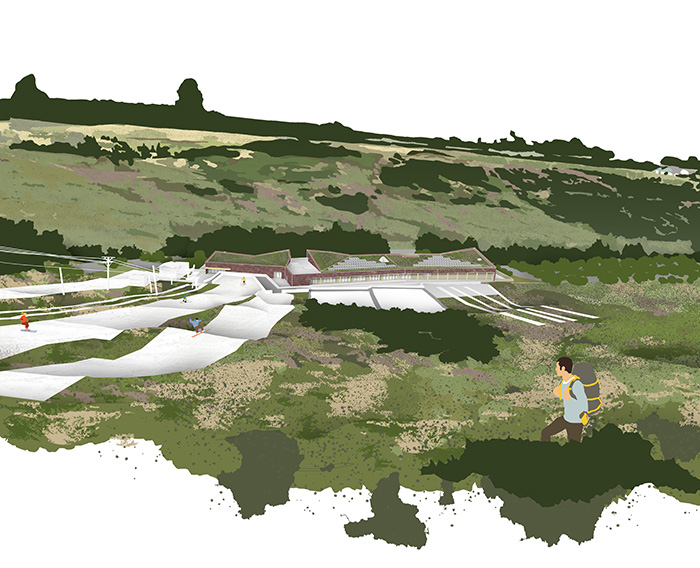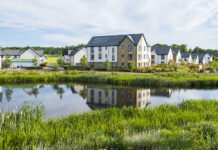
SMITH Scott Mullan Associates has announced that its plans for Destination Hillend, a new multi-activity national leisure destination on the Pentland Hills has been granted planning permission.
The principal aim is to create a building inspired by – and related to – its surrounding landscape in every season.
The starting point for the design was to create a linear volume, set into the hillside, that creates a point of arrival at the top of the access road and a new physical base to the existing ski slopes.
Smith Scott Mullan Associates explained that, as part of the design process, the volume was developed in the following ways: 1) Raised up to create a permeable ground floor; 2) Broken in two, to define activities and clearly mark the entrance; 3) The forming of subtle angles in plan to respond to the contours of the site; and 4) The introduction of undulating roof pitches to help define significant parts of the façade and create a geometric roof pattern appropriate for its context.
The resulting massing and shape of the proposed building abstractly references the undulating ridges and steep slopes of the Pentland Hills. The result is an undulating roof profile with clear high and low points defining the main entrance and gable ends of the new building.

The client’s brief was to create a building that acts a hub for multiple activities, including climbing, soft play, ski-hire, dining, events and retail. Built into the hillside, the building negotiates the steep topography and allows users to move from the access road level to the base of the ski slopes and other hillside activities, which will include a zipline, alpine coaster and tubing.
Given its position, nestled into the base of Caerketton Hill, the roof is highly visible to the public. When viewed from the ski slopes above, the hillside is not continuously smooth but uneven with bumps, dips and projections. The proposed roofscape reflects this, with a mix of slopes and raised sections that give the impression of undulations, breaking up the large mass of the building into smaller elements.
The building roof is then wrapped in a green sedum blanket to enhance biodiversity and embed the new forms into the hillside context, when viewed from above. The roof shape has also been rationalised to limit the number of pitches. The overall roof is read as a clear series of triangular shapes. This clarity in shape, Smith Scott Mullan Associates added, results in a strong geometric roof pattern which is distinguishable from the surrounding hills, whilst also sensitively respecting its natural context.
The form, mass, and profile of the building are each designed to harmonise with the natural terrain and preserve the existing character and profile of the slope. The building masses have been oriented to closely align with the existing contours of the slope. In doing so, the amount of cut and fill on the hillside is greatly reduced.

The first floor masses are clad in red terracotta tiles, referencing the terracotta roof tiles of historic agricultural buildings scattered across the Lothians. The first floor level sits on a light buff brick ground floor base course, designed to reflect the silver colour of the hillside grasses and bark of the many birch trees. Coloured glazed bricks mark the main entrances into the building, from both the concourse and the upper level terrace. The glazed bricks form a pattern said to abstractly echo the local hillside, using greens, yellows and purples, representing the hillside grasses, gorse flowers and heather respectively.
The development is targeting net zero in terms of operational carbon, using a fabric-first approach, and will utilise renewables for operational energy. Smith Scott Mullan Associates are now progressing technical design information for the new building.
Paul Campbell, project manager for Midlothian Council, said, “We’re hugely excited for this project that is providing a new outdoor activity centre in Midlothian. Getting planning approval for the main building reflects the hard work of the team and marks a significant milestone in the delivery of this project. We look forward to the works progressing in the near future.”
The project team is as follows:
- Client: Midlothian Council
- Architect: Smith Scott Mullan Associates
- Structural: Pick Everard
- M&E: Cundall
- QS: Thomson Bethune
- PM: Hardies Property & Construction Consultants
- Landscape: Wardell Armstrong
- Planning: Montague Evans
- CDM: Midlothian Council











